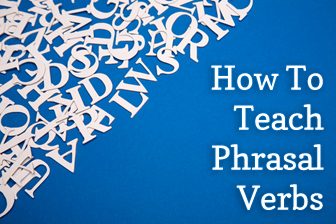Nine out of ten ESL students will tell you the hardest English vocabulary to learn are phrasal verbs, those sneaky little verbs that mean one thing when paired with one preposition and a completely different thing when paired with another.
And since it’s so hard for students to learn them effectively on their own, it’s up to us to help them. Now, if you’re in doubt as to which is the best way to teach phrasal verbs, here are some steps that might help you put them across:
How to Proceed
-
1
Choose a selection of 5 to 10 phrasal verbs
It is not entirely uncommon for students to receive long laundry lists of phrasal verbs to study, particularly for examinations like the TOEFL, but this is hardly the best way for them to really incorporate them into their vocabulary. So, put away the lists and choose a small selection (no more than ten) that falls into a logical group, either because they are paired with the same preposition or they fit into the same topic. Some examples:
- With this set of flashcards, you can teach some phrasal verbs with “out”.
- This Phrasal Verb Pyramid has phrasal verbs with the same verb, “put”, but different prepositions.
- Here are some phrasal verbs that are used in Business English. They are organized into a topic that will make them easier to remember.
- The same can be said for these phrasal verbs connected with food.
-
2
Introduce in context
You may be tempted to present each with a synonym or definition, but this may not give students a clear understanding of how each is used. For example, say you want to teach Business phrasal verbs. To present a phrasal verb like “take over”, try the following:
T: Did you hear about XYZ Company? This past week they bought the much smaller ABC Company. XYZ took over ABC.
If you supply real company names and real examples, so much the better, particularly if you’re teaching Business English students. They’ll really appreciate the examples and will easily understand the phrasal verb and how it’s used. Confirm by asking them the meaning of “take over”, in this case. Can they supply other examples of companies that were taken over recently?
Do the same with “go under”. Supply an example of a company that has filed for bankruptcy. Have any of your students heard about another company has gone under recently?
Make them figure out. Help them guess. Give them lots of examples. Use real companies, people and places. But above all, help them understand the phrasal verb, beyond the mere memorization of a definition.
Don’t forget this essential clarification: students must understand that phrasal verbs are more informal and are thus used more often in spoken rather than written English, although they may be used in informal written communication like emails to family or friends.
-
3
Students practice the new words
There are a number of ways in which students can practice their new phrasal verbs.
- Worksheets – Phrasal verbs with up, with on, with in - download some or make your own. Fill in the blanks or matching – give them plenty of opportunities to practice.
- Videos – This Phrasal Verbs and Mamma Mia movie workheet is a great example of how you can practice phrasal verbs with a movie or a video.
- Games – Bingo, Tic Tac Toe, or design your own board game. Just give students the synonym, for example, “postpone” and ask them to come up with the right phrasal verb, in this case, “put off”.
-
4
Students perform or produce with the new words
The goal, here, is to help students go from very controlled activities or exercises to using the new phrasal verbs on their own. To this end, you may ask them to:
- Give every pair of students 2-3 phrasal verbs that they must use in a conversation. Students come up with a dialogue, put it down on paper, and then act it out in front of the class.
- Give each student a set of phrasal verbs they must use in an email to a friend or family member. For example, they may use phrasal verbs connected with food to write about their Thanksgiving meal.
- Ask students to prepare a PowerPoint presentation that shows some examples of what you talked about in class. Business English students may research recent takeovers or bankruptcies to put on their slides.
Did you know we have our very own Phrasal Verbs section with almost 100 worksheets? Feel free to download some and put them to good use. And if you design some of your own, don’t forget to add them to our collection so that together we can reach that 100-worksheet marker!
Did you notice that in this article we used several phrasals of the same verb with different prepositions? See how many you can find and comment below! Hint: the first is in the title…
P.S. If you enjoyed this article, please help spread it by clicking one of those sharing buttons below. And if you are interested in more, you should follow our Facebook page where we share more about creative, non-boring ways to teach English.









